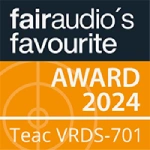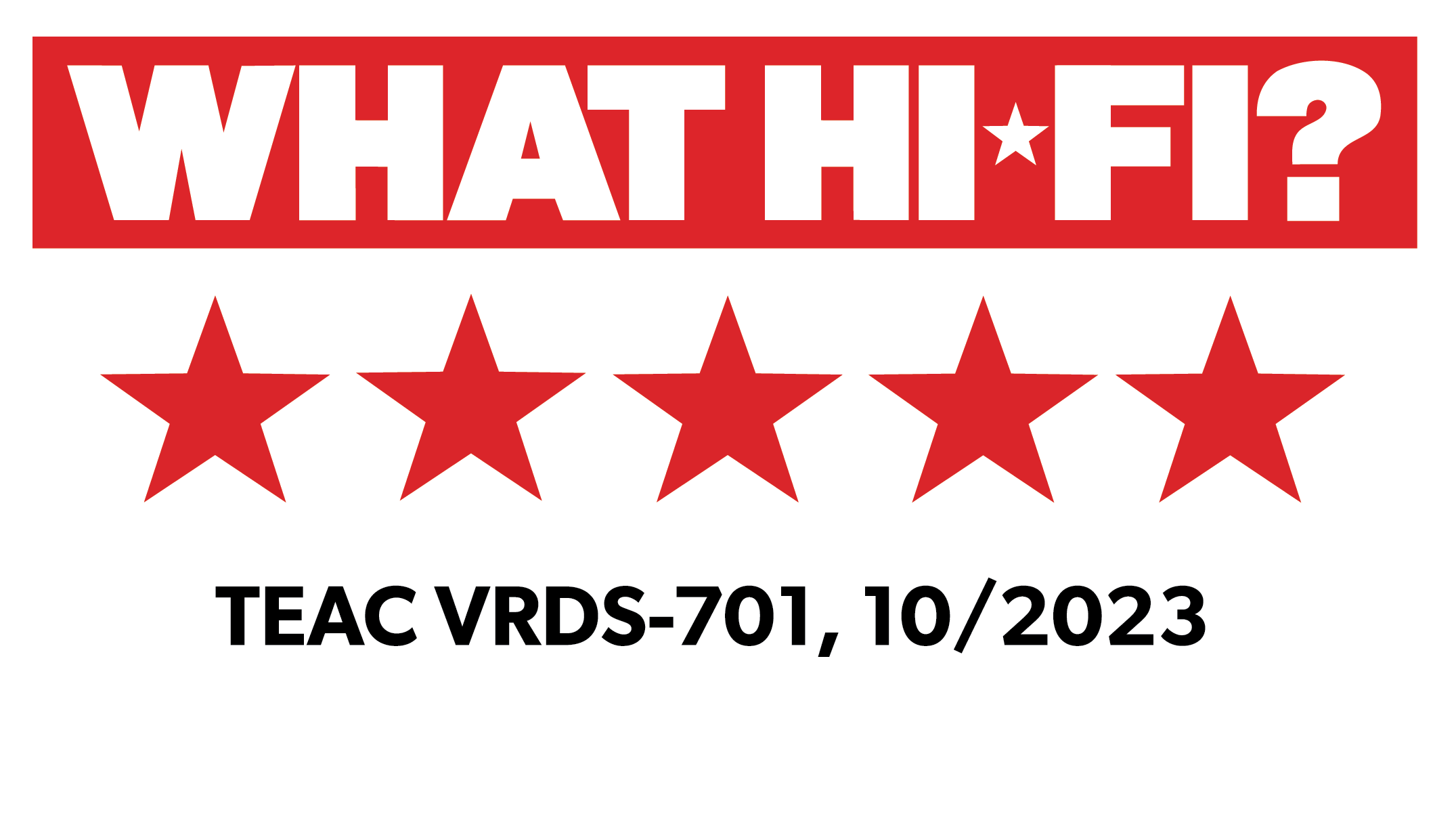Nieuw ontwikkeld VRDS-mechanisme
Gebaseerd op een door ons ontwikkelde discdrive die zich al lang bewezen heeft in de broadcastindustrie, hebben we VRDS-technologieën toegevoegd die deel uitmaken van ons TEAC-erfgoed.
Trillingsvrij klemsysteem voor harde schijven (VRDS)
Dit door TEAC ontwikkelde CD-aandrijvingsmechanisme vermindert de rotatietrilling van de schijf zelf en ongewenste aandrijvingstrillingen door de CD vast te klemmen op een aluminium draaitafel met dezelfde diameter en de traagheidsmassa te maximaliseren om de rotatie te stabiliseren. De servostroom wordt gereduceerd door de platter door de vervorming en vervorming van de CD en de relatieve optische as van de optische assen van de cartridge en de putzijde van de disc te corrigeren. Dit resulteert in minder leesfouten van de disc en een uitstekende audiokwaliteit.
Bruggedeelte ondersteunt de VRDS
Voor de brug die de platter ondersteunt, hebben we zorgvuldig lichtgewicht materialen geselecteerd die zeer stijf zijn en geen trillingen doorgeven. Door de natuurlijke trillingen snel te reduceren, hebben we een breed, dynamisch geluid gerealiseerd. De brug, die een torusstructuur van hars heeft, is slechts aan één kant bevestigd en de voortplanting van trillingen van het CD-mechanisme naar de andere kant via de brug wordt onderdrukt, zodat het hele mechanisme ongewenste resonantie minimaliseert.
Halfzwevend lager
Het volledige CD-mechanisme is semi-zwevend op het subchassis gemonteerd. Voorwaarde. Door de overdracht van trillingen tussen het CD-mechanisme en het chassis te regelen, wordt het effect van resonantie geminimaliseerd en wordt een natuurlijke weergave over het hele frequentiebereik bereikt. Door de motor te isoleren worden motortrillingen geïsoleerd van het hoofdchassis, waardoor resonantietrillingen binnen het chassis worden voorkomen. Tegelijkertijd wordt de CD-drive ook geïsoleerd van externe trillingen. Door het CD-mechanisme te isoleren van externe trillingen wordt ook de afleesnauwkeurigheid verhoogd. Mechanisme tegen externe trillingen.
TEAC ΔΣ (delta-sigma) discrete DAC
In plaats van een gewone DAC IC is het DAC-gedeelte dat cruciaal is voor het geluid een TEAC ΔΣ (Delta Sigma) discrete DAC, die bestaat uit een discrete circuitstructuur waarin onze unieke algoritmen met behulp van FPGA zijn geïntegreerd. DSD-signalen blijven ongewijzigd, terwijl PCM-signalen worden omgezet naar 1-bit signalen met behulp van een ΔΣΣΣΣΣΤ. en vervolgens worden uitgevoerd als hoogwaardige analoge signalen. Het geluidsveld, dat breed en perfect helder is, kan alleen worden bereikt dankzij deze discrete structuur. Het resultaat is dat we kunnen zeggen dat we het geluid hebben bereikt waar TEAC naar streeft. Met een TEAC ΔΣ discrete DAC is weergave van 22,5MHz DSD en 384kHz/32-bit PCM data mogelijk.
Dubbele monostructuur
Met onafhankelijke ringkerntransformatoren links en rechts hebben we een circuit van de voeding naar de D/A-omzetter naar de voeding naar de D/A-omzetter naar de analoge eindtrap.
De dubbele monostructuur bestaat uit twee circuits die een volledig monopad bieden voor elk kanaal. Dit voorkomt interferentie tussen het linker- en rechtersignaal en zorgt voor een rijke muzikale expressie die de perceptie van geluidsruimte en driedimensionaliteit benadrukt.
Volledig gebalanceerde transmissie in elke fase
De volledig gebalanceerde overdracht van de linker en rechter analoge uitgangssignalen van D/A-omzetting naar de uiteindelijke eindtrap draagt aanzienlijk bij aan de verbetering van de signaal-ruisverhouding en de uitbreiding van het dynamische bereik. Het gevoel van lucht dat audiobronnen met een hoge resolutie hebben, kan verliesvrij worden overgebracht in een nog zuiverder vorm.
Directe aansluiting is mogelijk met eindversterkers die gebruik maken van TEAC QVCS
Deze speler kan rechtstreeks op een eindversterker worden aangesloten en zonder voorversterker worden gebruikt TEAC-QVCS, een analoge versterker met variabele versterking en verzwakker met een volledig gebalanceerde structuur. TEAC-QVCS (Quad Volume Control System) is een analoge volumeregelaar met variabele versterking bestaande uit vier discrete linker, rechter, positieve en negatieve (L+, L-, R+ en R-) circuits. Dit voorkomt theoretisch "versnellingsfouten" (niveauverschillen tussen linker- en rechterkanalen bij lage volumes) en maakt een uiterst nauwkeurige analoge volumeregeling mogelijk in stappen van 0,5 dB van -95 dB tot +24 dB. De twee sets analoge uitgangen (gebalanceerd/ongebalanceerd) kunnen worden ingesteld op vaste of variabele uitgang.
Een volledige MQA-decoder maakt het afspelen van MQA-cd's mogelijk.
MQA (Master Quality Authenticated) is een hoogwaardige audiocodec voor het afspelen van muziek met de compromisloze kwaliteit van de master opgenomen in de studio. De VRDS-701 bevat een MQA-decoder die digitale naar analoge golfvormen converteert met een nauwkeurigheid tot 5 ms, om analoge naar analoge golfvormen te verkrijgen die nog getrouwer zijn aan de originele geluidsbronnen. Door de "temporele wazigheid" die optreedt op plaatsen met extreme geluidsdrukverschillen, bijvoorbeeld wanneer geluiden plotseling beginnen, sterk te verminderen, kan de reproductie van geluiden dicht bij het menselijk gehoor worden bereikt. De integratie van een MQA-decoder maakt niet alleen het genieten van MQA-cd's mogelijk, maar ook het decoderen van MQA-gegevens via de digitale ingangen en het afspelen van MQA-bestanden vanaf een computer bij gebruik als USB DAC.
Als USB DAC kunnen 22,5MHz DSD- en 384kHz/32-bit PCM-gegevens worden afgespeeld.
Een USB Type-C aansluiting is beschikbaar voor digitale invoer. De VRDS-701 is veel meer dan een CD-speler. Als hij via USB is aangesloten op een computer, kan hij worden gebruikt als een USB DAC, zodat u kunt genieten van de wereld van computeraudio met audiobronnen met hoge resolutie.
2×, 4× en 8× upconversie met RDOT-NEO
RDOT-NEO (Refined Digital Output Technology NEO), dat digitale audiosignalen voorzichtig verbetert, biedt een functie voor het 2×, 4× of 8× upconverteren van de samplefrequentie van PCM digitale signalen (tot 384 kHz). RDOT, dat een analoog-naar-analoog interpolatiemethode toepast met fluence logica, is een technologie die is ontwikkeld om frequenties boven de 20 kHz te kunnen afspelen die verloren gaan in het 44,1 kHz/16-bits CD-formaat. Op basis van de informatie die van de CD wordt gelezen, worden analoge gegevens gegenereerd tussen de golfvormmonsters. Hierdoor worden ook gegevens boven de 20 kHz gegenereerd.
10MHz externe klokingang
De 10MHz klokingang maakt synchronisatie met een externe klokgenerator mogelijk. Dit verbetert niet alleen de geluidskwaliteit tijdens het afspelen met de VRDS-701, maar maakt het ook mogelijk om het hele systeem te synchroniseren met een klokgenerator.
Hoge-precisie dubbele klok voor 44,1kHz en 48kHz veelvouden met lage faseruis
Deze speler heeft kristaloscillatoren met hoge precisie en lage faseruis. Naast 44,1kHz voor CD-weergave ondersteunt hij ook een 48kHz klok, die nodig is voor het afspelen van bestanden van een computer bij gebruik als USB DAC.
Voeding verbeterd door drie krachtige ringkerntransformatoren
Naast een ringkerntransformator voor de analoge signalen hebben de digitale besturingseenheid en het CD-mechanisme elk onafhankelijke ringkerntransformatoren. Door constante stroom te leveren via deze drie ringkerntransformatoren kunnen de plotselinge starts en stops van geluiden duidelijk worden weergegeven en kan een uitstekende geluidslineariteit worden bereikt. De transformatoren zijn elk op het subchassis gemonteerd om trillingen onder controle te houden.
TEAC-HCLD2 Bufferversterkerschakeling met verhoogde uitgangsstroom
Het TEAC-HCLD 2 circuit voor het analoge uitgangscircuit is een versterkte uitgangsbufferversterker die de stroomoverdracht aanzienlijk verbetert. Dit model maakt gebruik van diamanten bufferversterkers met een hoog uitgangsvermogen als drivers. Door gebruik te maken van een positief-negatieve tweekringstructuur voor elk kanaal kan de aandrijving differentieel zijn met gebalanceerde uitgang en parallel met ongebalanceerde uitgang. De overdracht van audiosignalen zonder afbreuk te doen aan hun dynamiek is mogelijk met een verhoogde voedingscapaciteit.
Hoofdtelefoonversterker
De hoofdtelefoonversterker heeft een speciale driver die gebruik maakt van een circuit met hoog uitgangsvermogen en lage vervorming, een hoge signaal-ruisverhouding en een hoge doorlaatfrequentie van 2000V/μs, wat overeenkomt met een driver die de vermogensoverdracht verbetert. Dit maximaliseert het potentieel van uw hoofdtelefoon.
Bulk Pet USB-communicatietechnologie maakt stabiele gegevensoverdracht mogelijk
Bij het verzenden van grote hoeveelheden digitale gegevens voor audiobronnen met hoge resolutie via USB-kabels kunnen er grote verschillen optreden in de verwerkingsprestaties van zowel de verzendende computer als de ontvangende USB DAC. Dit creëert de mogelijkheid van audio dropouts en andere problemen. Met de Bulk Pet USB-transmissietechnologie wordt echter een constante transmissie met een vast datavolume bereikt en is een gelijkmatige gegevensoverdracht mogelijk door de verwerkingsbelasting aan beide kanten af te vlakken. Aangezien de geluidskwaliteit kan worden veranderd door de belasting van de computer op de computer te veranderen, kun je vier vooraf ingestelde transmissiemodi selecteren, afhankelijk van de gewenste geluidskwaliteit.
Geavanceerd ontwerp voor trillingscontrole
De voedingstransformatoren, die gevoelig zijn voor trillingen, zijn gemonteerd op een zwevende structuur die ze scheidt en isoleert van de basisplaat. De ribben aan de zijkant voor warmteafvoer zijn zo gesneden dat elke rib een andere lengte heeft om resonantie te voorkomen.
Drie ondersteunende, puntvormige voeten van gefreesd staal met een unieke structuur
De bevestigingsschroeven voor de printplaat zijn tot een minimum beperkt. Daarnaast zijn er stalen puntvormige voetjes die gebruikmaken van een origineel TEAC-ontwerp met een nieuwe structuur om te zorgen voor voldoende speling in de verbinding tussen de voetjes en de bodemplaat om trillingen die de geluidskwaliteit zouden kunnen beïnvloeden, grondig onder controle te houden. geluidskwaliteit.
Controlepoorten maken gecoördineerd gebruik met andere apparaten mogelijk
RS-232C is voorzien voor integratie met gangbare besturingssystemen en trigger-ingangs- en uitgangsaansluitingen maken gecoördineerd gebruik van voeding met andere apparaten mogelijk.
TEAC HR Audio Player gratis meegeleverd
Audiobronnen met hoge resolutie, tot 22,5 MHz DSD of 384 kHz/32 bit PCM, kunnen worden afgespeeld vanaf Windows- en Macintosh-computers met deze gratis software. Software. Digitale audiogegevens kunnen met een gerust hart onder de beste omstandigheden worden overgedragen door simpelweg de software te starten en de VRDS-701 te selecteren die via een USB-kabel is aangesloten. Aangezien de software is ontwikkeld voor gebruik met dit product, is het maken van USB-audio-instellingen eenvoudig.
Meegeleverde accessoires
- Stroomkabel
- Afstandsbediening (RC-1338)
- Droge batterij (AAA) x2
- Deurmat x3
- Gebruikershandleiding
CD-R
CD-RW
MQA-CD
4.0Vrms (1kHz Full scale 10kΩ loaded FIXED +6dB)
6Vrms (1kHz Full scale 10kΩ loaded VRIABLE)
Output impedance: 180Ω
4.0Vrms (1kHz Full scale 10kΩ loaded FIXED +6dB)
12Vrms (1kHz Full scale 10kΩ loaded VARIABLE)
Output impedance: 220Ω
Afstandsbediening
RS-232



